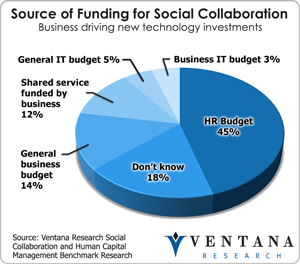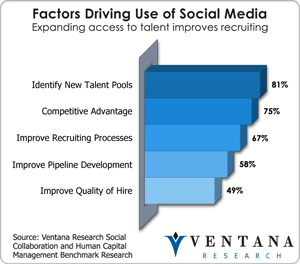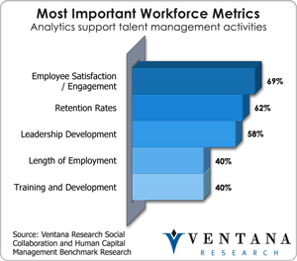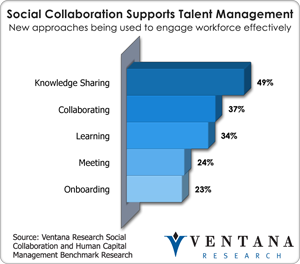IBM has announced its intention to acquire Kenexa as part of IBM Smarter Workforce initiative and social business software division. It’s a billion-dollar-plus investment to bolster IBM’s social business and give the company more depth in the human capital management software market that comprises human resources, talent management and workforce management. A lot of surface-level analysis I’ve seen on this announcement is not worth reading, but the deeper review below may help Kenexa and IBM customers, along with the market at large, and understand the implications of this announcement.
Social collaboration in business applications is advancing rapidly; I have already written about our research detailing the benefits and  best practices some early adopters have found. With social collaboration software, customers’ buying dynamic does not come from IT but rather HR and operational management, and this kind of software is not something executives are buying off the shelf.
best practices some early adopters have found. With social collaboration software, customers’ buying dynamic does not come from IT but rather HR and operational management, and this kind of software is not something executives are buying off the shelf.
Kenexa uses a lot of fancy business marketing words like enriching lives to describe what it does on its website. Its annual report states :
“We are a leading provider of software-as-a-service, or SaaS, solutions that enable organizations to more effectively recruit, retain and develop employees. Our solutions are built around a suite of easily configurable software applications that automate talent acquisition and employee performance management best practices.”
This positioning has evolved from the acquisitions Kenexa has made to help the company grow its software portfolio. The company sources the majority of its software revenue from its recruiting related software and its outsourcing and consulting services of hiring activities. It has been effective at using its own products within its recruitment process outsourcing (RPO) and licensing them to meet customer needs. But Kenexa was not advancing as quickly as it should have in embracing social media as a channel for recruiting – a factor that our social recruiting benchmark identified as a top priority for identifying new talent pools. Kenexa has recently gotten more engaged into supporting social media. Other software providers have advanced more rapidly in support social media and other innovations in recruiting, such as Talemetry’s support for social media and verification of resumes and HireVue’s video interviewing on smartphones.
effective at using its own products within its recruitment process outsourcing (RPO) and licensing them to meet customer needs. But Kenexa was not advancing as quickly as it should have in embracing social media as a channel for recruiting – a factor that our social recruiting benchmark identified as a top priority for identifying new talent pools. Kenexa has recently gotten more engaged into supporting social media. Other software providers have advanced more rapidly in support social media and other innovations in recruiting, such as Talemetry’s support for social media and verification of resumes and HireVue’s video interviewing on smartphones.
Kenexa has been challenged when it comes to organic product development in its talent management portfolios, but it has made many acquisitions in the last two years to expand its applications footprint in this area. Kenexa’s own 2X Perform offering for performance management was slow to evolve, but even acquiring additional software assets and people to help its efforts is only beginning to help increase adoption across its own customer base, let alone give the company the ability to compete with others in the market. While Kenexa had been positioning itself as a talent management application suite provider, it really was focused on its recruiting application and outsourcing and consulting services.
In recent years Kenexa has worked to bolster its software portfolio. For instance, in compensation it had no real offering until it acquired Salary.com two years ago. Yet my analysis shows Kenexa has not really integrated Salary.com and operates as a division, and has seen little growth in adoption of its applications in the last 18 months. The company has been unresponsive to our attempts to compare its application to others that our firm assessed in our Value Index for Total Compensation Management, though we have written how hot this application segment is recently.
In 2012 Kenexa acquired OutStart, a learning management system (LMS) provider that needed to align with an overall talent management offering to be competitive with other integrated approaches. The company started the integration process this year, so it is still too early to tell how much value the acquisition will have for Kenexa customers, especially now that Kenexa will have to deal with the larger challenge of integration with IBM.
 Kenexa talks about the value of analytics in its marketing material, but no solution dedicated to this area is listed on its website or annual report. Our benchmark research has found that workforce metrics are critical for talent management, yet Kenexa remains one of the only talent management vendors without a robust workforce analytics software offering. It also has struggled to advance smartphone and tablet access to its applications. Kenexa early attempt were not fully ready for the market and currently has one native application for the Apple iPhone that helps in specific tasks in recruiting which is well behind others in the market. Kenexa has been relatively slow to include social media as a channel for recruiting.
Kenexa talks about the value of analytics in its marketing material, but no solution dedicated to this area is listed on its website or annual report. Our benchmark research has found that workforce metrics are critical for talent management, yet Kenexa remains one of the only talent management vendors without a robust workforce analytics software offering. It also has struggled to advance smartphone and tablet access to its applications. Kenexa early attempt were not fully ready for the market and currently has one native application for the Apple iPhone that helps in specific tasks in recruiting which is well behind others in the market. Kenexa has been relatively slow to include social media as a channel for recruiting.
All of these issues are results of the company’s limited investment in R&D as a percentage of overall revenue. Its annual report shows only 6.7 percent of total revenue in 2011 went toward R&D, which is one of the lowest percentages in the industry. While the percentage increased in the first half of 2012 according to my analysis of the company’s financial reports, part of that is due to the acquisition of OutStart, which brought additional people to R&D and also more experience in support mobile technologies. At the same time, general and administrative operating expenses were a hefty 19.1 percent of total revenue. IBM must now decide how to handle these high people-related expenses, and how to better balance the number of chiefs and administrators versus workers in R&D. Meanwhile, Kenexa was struggling to reach a target level of profitability, but all of its financial statements show it had grown revenue at the expense of profits.
Kenexa lacks a social collaboration framework to help its customers provide methods to more fully engage its employees, as competitors such as Oracle, Peoplefluent, Saba, SAP and Workday already have in place. Kenexa also did not have an integrated set of talent management applications, but had acquired its way into the market and did not make the acquired products integrate to the level that most software companies do. IBM should be able to help here, as it can integrate its social collaboration framework with the Kenexa applications – it did not already have an integrated or unified approach to its applications – but assimilating Kenexa may take some time.
For the last several years IBM has been acquiring business application vendors. By all accounts it is efficient at integrating acquisitions, and is overall a profitable global company. Meanwhile, IBM has struggled in gaining adoption of its social business software into business areas including the talent management and overall human capital management market. But Kenexa may prove to be a difficult meal to digest, as this is the first time IBM has acquired a provider in the talent management market and the broader human capital management category and a company who has many acquired products that are yet to be fully integrated. This is a business application segment that also operates using software as a service (SaaS) and cloud computing – areas in which IBM lacks a lot of experience in the business applications area. IBM will quickly learn it will have to make a significant investment in product development to advance this talent management suite offering to complete with software providers that are already selling to HR and executive and business management. Kenexa had a large consulting and delivery team that, according to its annual report, includes 1,637 of its 2,744 employees. Those employees will need to integrate into IBM global services, a very large organization with a different culture and methods of operation.
When this acquisition is complete, Kenexa customers should not expect any immediate product advancements, as the software will need what IBM insiders call ”blue washing,” and that will overwhelm whatever resources are available for integration with IBM social business products. Given Kenexa’s smaller-than-normal investment in R&D, and IBM’s requirements, I expect the cycle of innovation to be very limited. In the medium term, IBM may see a customer and revenue opportunity in integrating its suite of analytics, planning and performance management technology and adapting it to human capital and workforce needs. For IBM and its social business customers, this category of application was probably not as important as it should be but will need to reach to HR and executives to garner any interest. Though eventually it should be worth looking at more closely, it will be some time before any integrated release, and there are already alternative approaches available in the market.
For IBM’s part, this acquisition is important because its social and collaborative efforts have struggled to get more deeply business-focused, and that is a buying requirement that we have found in areas like sales, customer service, marketing, human resources and operations. This is why we’ve seen deals like Salesforce.com’s acquisition of companies like Rypple to help in its social collaboration efforts.
Is the billion-dollar-plus investment worth it for IBM? Well, IBM is a master at leverage and gaining value from acquisitions – but so are competitors Oracle and SAP, and they already sell social collaboration in talent management. IBM will need to ensure it can meet the new social collaboration needs for talent management in such areas as knowledge sharing, collaboration and learning that are benchmark research finds important. In the short term, Kenexa and IBM will struggle, as competitors can market products that are already integrated. This acquisition could become a distraction and resource drain for IBM. It will be difficult for Kenexa to gain a competitive edge for integrated and unified talent management; it has not yet completed this task by itself, and now it faces integration with IBM social business technologies, which will require more R&D investments by IBM. On the plus side, IBM’s opportunity to advance its consulting services in areas like recruiting, employee assessment and other related areas will help bolster its global footprint. Here, the billion-dollar investment will pay off sooner but with lower margins unless it can convince customers to adopt its software as part of its consulting engagements.
at leverage and gaining value from acquisitions – but so are competitors Oracle and SAP, and they already sell social collaboration in talent management. IBM will need to ensure it can meet the new social collaboration needs for talent management in such areas as knowledge sharing, collaboration and learning that are benchmark research finds important. In the short term, Kenexa and IBM will struggle, as competitors can market products that are already integrated. This acquisition could become a distraction and resource drain for IBM. It will be difficult for Kenexa to gain a competitive edge for integrated and unified talent management; it has not yet completed this task by itself, and now it faces integration with IBM social business technologies, which will require more R&D investments by IBM. On the plus side, IBM’s opportunity to advance its consulting services in areas like recruiting, employee assessment and other related areas will help bolster its global footprint. Here, the billion-dollar investment will pay off sooner but with lower margins unless it can convince customers to adopt its software as part of its consulting engagements.
Regards,
Mark Smith – CEO & Chief Research Officer














